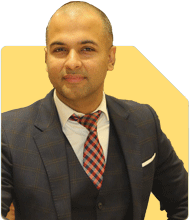Ramalingam Kalirajan |8204 Answers |Ask -Follow
Mutual Funds, Financial Planning Expert - Answered on Jun 11, 2024
He has an MBA in finance from the University of Madras and is a certified financial planner.
He is the director and chief financial planner at Holistic Investment, a Chennai-based firm that offers financial planning and wealth management advice.... more
.jpg)
I am about to retire from Govt job in June 2025 with retirement corpus of around 70 lacs and a monthly pension of 42k.. My monthly expenses is around 30k .. With no any liability and savings apart from retirement corpus.. What do I need to do to accumulate fund of around 5 crore in next 10 years.. Please mark your suggestions...
Assessing Your Current Financial Situation
Understanding your current financial position is crucial for effective planning. You have no liabilities and a steady monthly pension that covers your expenses. This surplus can be strategically invested to grow your wealth. Here’s a breakdown of your financial situation:
Retirement Corpus: Rs 70 lakhs
Monthly Pension: Rs 42,000
Monthly Expenses: Rs 30,000
Monthly Surplus: Rs 12,000
Setting Clear Financial Goals
Your objective is to accumulate Rs 5 crore in 10 years. To achieve this, we need to establish a clear savings and investment strategy. Here’s how we can break down the process:
Calculate the Total Savings Needed: Understand the future value required and the necessary monthly contributions.
Establish a Savings and Investment Plan: Leverage your retirement corpus and monthly surplus effectively.
Estimating Growth with Compound Interest
Compounding is a powerful tool for wealth accumulation. We will use it to project the growth of your retirement corpus and monthly surplus. Assuming an annual return of 12%, a realistic expectation for a diversified investment portfolio, we can calculate the future value of your investments.
Formula: Future Value = P * (1 + r/n)^(nt)
Where:
P = Principal amount (Rs 70 lakhs)
r = Annual interest rate (0.12)
n = Number of times interest is compounded per year (12)
t = Number of years (10)
Using these variables, we can calculate the future value of your retirement corpus and monthly investments.
Choosing the Right Investment Vehicles
Selecting suitable investment options is key to maximizing returns. Here are some options to consider:
1. Mutual Funds
Mutual funds offer diversification, professional management, and liquidity. Actively managed mutual funds are preferable for potentially higher returns.
Equity Mutual Funds: These funds invest in stocks and have the potential for high returns, suitable for long-term growth.
Debt Mutual Funds: These funds invest in fixed-income securities, providing stability and regular income.
2. Systematic Investment Plan (SIP)
A SIP allows you to invest a fixed amount regularly in mutual funds. This approach ensures financial discipline and benefits from rupee cost averaging, reducing market volatility impacts.
Advantages of SIP:
Regular investments minimize market timing risks.
Helps in building a significant corpus over time.
Calculating Future Value of SIP
Assume you invest Rs 12,000 monthly via SIP in equity mutual funds with an expected return of 12% per annum.
Formula: Future Value of SIP = P * ((1 + r/n)^(nt) - 1) / (r/n)
Using this formula with:
P = Rs 12,000
r = 0.12
n = 12
t = 10
This will determine the future value of your SIP investments.
Balancing Your Investment Portfolio
Diversifying your portfolio is crucial to minimize risks and optimize returns. A balanced portfolio includes both equity and debt investments.
1. Equity Mutual Funds:
Large-Cap Funds: Invest in large, stable companies. They offer stability and moderate returns.
Mid-Cap and Small-Cap Funds: Invest in medium and small-sized companies with high growth potential. These are riskier but can yield higher returns.
2. Debt Mutual Funds:
Short-Term Debt Funds: Suitable for conservative investors, offering lower returns but higher stability.
Long-Term Debt Funds: These can provide better returns compared to short-term funds and are less volatile than equity funds.
Periodic Review and Rebalancing
Regularly reviewing and rebalancing your investment portfolio ensures it remains aligned with your financial goals and risk tolerance.
1. Annual Review:
Assess the performance of your investments.
Adjust the allocation between equity and debt funds if necessary.
Ensure your portfolio remains diversified and aligned with your retirement goal.
Tax Considerations
Understanding the tax implications of your investments helps maximize returns. Different investment vehicles have varying tax treatments.
1. Equity Mutual Funds:
Long-Term Capital Gains (LTCG): Gains over Rs 1 lakh in a financial year are taxed at 10%.
Short-Term Capital Gains (STCG): Gains are taxed at 15%.
2. Debt Mutual Funds:
LTCG: Gains are taxed at 20% after indexation.
STCG: Gains are added to your income and taxed as per your income slab.
Utilizing Tax Saving Instruments
Investing in tax-saving instruments under Section 80C of the Income Tax Act can reduce your taxable income. However, ensure these investments align with your overall financial plan.
1. Equity-Linked Savings Scheme (ELSS):
ELSS funds provide tax benefits under Section 80C and have a mandatory lock-in period of three years. They primarily invest in equities and can offer substantial returns.
2. Public Provident Fund (PPF):
PPF is a long-term savings instrument with tax benefits. The interest earned and the maturity amount are tax-free, providing a safe investment option.
Retirement Corpus Calculation
Let’s summarize the future value calculation for your retirement corpus and SIP investments to estimate the corpus at retirement.
Retirement Corpus (P): Rs 70 lakhs
Monthly SIP (P): Rs 12,000
Annual Interest Rate (r): 12%
Compounding Frequency (n): 12
Investment Period (t): 10 years
Using the future value formula, we can calculate the corpus at retirement. This projection will show if your investments will meet the Rs 5 crore target.
Monitoring Inflation
Inflation erodes purchasing power over time. Considering inflation in your retirement planning ensures that your corpus retains its value.
1. Inflation Rate Assumption:
Assume an average inflation rate of 6% per annum. This impacts the real value of your retirement corpus.
2. Adjusting for Inflation:
Calculate the inflation-adjusted value of Rs 5 crore.
Ensure your investments grow at a rate higher than inflation.
Risk Management
Investing involves risks, and managing these risks is crucial for financial stability. Diversifying your investments and choosing a mix of assets can mitigate risks.
1. Market Risk:
Equity investments are subject to market volatility. Diversification across sectors and companies reduces this risk.
2. Credit Risk:
Debt investments carry credit risk, the possibility of default by issuers. Selecting high-quality debt instruments minimizes this risk.
Seeking Professional Guidance
While you can manage your investments independently, seeking advice from a Certified Financial Planner (CFP) can provide personalized strategies.
1. Advantages of CFP:
Expertise in financial planning and investment management.
Personalized advice based on your financial goals and risk tolerance.
2. Periodic Consultations:
Regular meetings with a CFP ensure your investment strategy remains on track. Adjustments based on market conditions and life changes can be made promptly.
Final Insights
Achieving a retirement corpus of Rs 5 crore in 10 years is ambitious but attainable with strategic planning and disciplined investing. Your current retirement corpus of Rs 70 lakhs and a monthly pension of Rs 42,000 provide a strong foundation. By leveraging the power of compound interest, diversifying your portfolio, and periodically reviewing your investments, you can reach your goal.
A combination of equity and debt mutual funds, along with a systematic investment plan (SIP), provides a balanced approach. Consider tax implications and adjust for inflation to maintain the real value of your corpus.
Remember, investing is a journey that requires regular monitoring and adjustments. Stay informed, seek professional guidance when necessary, and remain committed to your financial goals.
Best Regards,
K. Ramalingam, MBA, CFP,
Chief Financial Planner,
www.holisticinvestment.in
You may like to see similar questions and answers below
Ramalingam Kalirajan |8204 Answers |Ask -Follow
Mutual Funds, Financial Planning Expert - Answered on Apr 30, 2024
Ramalingam Kalirajan |8204 Answers |Ask -Follow
Mutual Funds, Financial Planning Expert - Answered on Jul 16, 2024
Milind Vadjikar |1157 Answers |Ask -Follow
Insurance, Stocks, MF, PF Expert - Answered on Nov 06, 2024
Moneywize |181 Answers |Ask -Follow
Financial Planner - Answered on Feb 06, 2025
Anu Krishna |1577 Answers |Ask -Follow
Relationships Expert, Mind Coach - Answered on Apr 09, 2025
Samraat Jadhav |2250 Answers |Ask -Follow
Stock Market Expert - Answered on Apr 08, 2025
T S Khurana |438 Answers |Ask -Follow
Tax Expert - Answered on Apr 08, 2025
T S Khurana |438 Answers |Ask -Follow
Tax Expert - Answered on Apr 08, 2025
Mihir Tanna |1043 Answers |Ask -Follow
Tax Expert - Answered on Apr 08, 2025
Harsh Bharwani |79 Answers |Ask -Follow
Entrepreneurship Expert - Answered on Apr 08, 2025
Milind Vadjikar |1157 Answers |Ask -Follow
Insurance, Stocks, MF, PF Expert - Answered on Apr 08, 2025
Milind Vadjikar |1157 Answers |Ask -Follow
Insurance, Stocks, MF, PF Expert - Answered on Apr 08, 2025
Milind Vadjikar |1157 Answers |Ask -Follow
Insurance, Stocks, MF, PF Expert - Answered on Apr 08, 2025
Milind Vadjikar |1157 Answers |Ask -Follow
Insurance, Stocks, MF, PF Expert - Answered on Apr 08, 2025




























